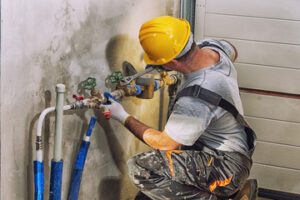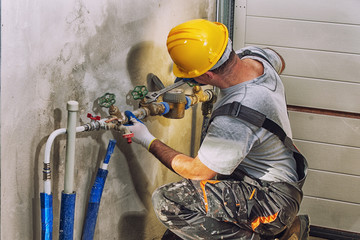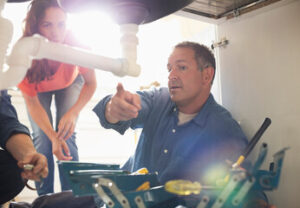Plumbers must be able to read and interpret blueprints and understand local plumbing codes and regulations. They often work with construction teams and architects to integrate plumbing into building projects seamlessly.
Plumber Linden NJ also deals with customers regularly, so they need to have excellent customer service skills. They should be able to explain complex issues in simple terms and provide accurate estimates for their work.
Leak detection devices are used to help identify the presence and location of leaks in pipes, boilers, fuel tanks, and other pressurized systems. They typically monitor the rate of fluid flow, pressure change, and water usage to detect changes that may indicate the presence of a leak. These sensors can be a hardware or software-based. Hardware-based systems use sensors that physically detect a leak and assist in locating it, such as acoustic emission detectors or negative pressure detection. Software-based systems use computer software packages that constantly monitor data, such as water usage and flow rate, and analyze it to detect anomalies.
These devices can be very useful in reducing waste from leaks, but they don’t always provide the most accurate information. They can be prone to false readings and may not be able to distinguish between normal water flows and the sound of running faucets or flushing toilets. A skilled plumber can also utilize other tools and techniques to locate leaks, such as the use of line tracing equipment, hydrostatic pressure testing, and camera pipe inspections.
Point-of-use leak detectors are designed to be placed in close proximity to the leak source, such as under sinks or near appliances like washing machines and boilers. They use sensors to detect water conditions and trigger an alarm if they sense a leak. These types of devices can be a good investment to help reduce the risk of leaks from these sources that can cause costly damage.
A more advanced type of leak detection is a system that mounts inline before the home’s water meter and contains an actuatable shut-off valve that can be triggered remotely or automatically, either through a smartphone app or from a home control panel. This can help to limit the amount of water that is wasted in the event of a leak or plumbing catastrophe and can save homeowners money on their water bills.
Flo and Flume are two popular products that offer this type of comprehensive leak detection and shut-off system for homes. While these products require professional installation and integration into the home’s plumbing, they can be programmable to allow you to customize water shut-off settings based on your household’s typical water usage patterns and can connect to a smart device, such as a phone or tablet.
Pipe Locators
If you’re a plumber or a construction company, a pipe locater can be your best friend. These devices allow you to check for buried pipes and cables before starting any work, which can prevent injury or expensive repairs later on. Tiger Supplies has a range of reliable pipe and cable locators, including models from top brands like Leica and Geomax.
These metal detectors emit a signal into the ground and listen for low sounds that bounce back up to locate underground pipes or wires. They can be used to find water, sewer, gas, or power lines. They are also useful in detecting leaks. Some can detect a sound vibration from a leak even in hard surfaces such as concrete, gravel, or bricks.
There are some limitations to using this device though. It does not locate plastic or non-metal utilities unless they have a tracer wire buried alongside or included with them. This makes them conductive and allows the locator’s signal to transmit down them. If you do have a non-metal utility with a tracer wire then a flexible tracer rod (also known as a Rodder) or a tracker cable with a 512hz sonde head can be fed into the pipe to enable the locator’s signal to be transmitted down it, allowing you to track it and find the location of your pipe or utility.
Some pipe locators also have a passive mode that capitalises on frequencies naturally emitted from underground pipes and cables. This can be much more difficult to use and requires a good amount of practice but it can save you some time in the long run by not needing to use a tracer wire.
It can be difficult to locate plastic pipes in hard ground or swampy or water-saturated soil, as the pipes will absorb the leak sound vibrations and make it harder to hear. It is also not as effective at locating leaks in soft dirt or newer leaking pipes. Older leaking pipes or those in rocky or hard soil tend to transmit leak sounds better and are easier to pinpoint.
Pipe Tape
Pipe tape is a simple but effective tool to help fix leaks from damaged or loose pipe threads. It is available at most hardware stores and can be easily applied to a leaky pipe. To apply plumber’s tape, first make sure the pipe threads are clean and dry. After that, start wrapping the tape around the threads, being careful not to over-wrap. Ensure each new wrap covers at least half of the previous one. This helps to prevent a buildup of material which can lead to clogs or reduced water pressure. Also, be careful not to overhang the end of the pipe as this can restrict water flow.
Most plumbers keep a roll of this on hand as it is useful in fixing both leaky joints and leaking connections. It is also an excellent alternative to pipe joint compound and can be used in a wide variety of pipe materials. Plumber’s tape can be applied to both metal and plastic pipe threads, although some types of pipe may require a different type of tape or compound for a proper seal.
Like all tapes, there are a number of different varieties of plumber’s tape, each with its own benefits and uses. It comes in a range of widths, colors and densities and is often used to identifies specific piping materials. It can withstand a wide range of temperatures and can be used to lubricate or seal mating pipe threads, making it easier to screw or unscrew them.
Often, when a pipe is leaking, it is due to the connection being loose or the old putty wearing off the threads. Using pipe tape can help to remedy these problems by creating a waterproof seal around the leaking threads of a pipe. This can be a permanent solution or simply a temporary repair until the plumbing company can get to the problem.
Before applying the tape, be sure to turn off the water. Next, dry the area around the leaky pipe and then place the tape over the threads of the connecting pipes. The tape should be wrapped tightly, overlapping several times. When finished, the tape can be cut or broken off the roll and smoothed over the pipe threads to prevent snags.
Drain Cleaning
Clogged drains are one of the most common plumbing problems and can cause many issues, such as slow drainage, unpleasant odors, water contamination, pests, and even health risks. Getting your drains cleaned regularly by a professional plumber can help prevent these issues from happening in the first place.
Slow draining sinks, bathtubs, showers and toilets are a sure sign that you may have a drain blockage. Hair, soap scum, dental floss, food particles, grease and other foreign materials gradually build up in your drains, restricting water flow. If left untreated, the problem can get worse and result in costly repairs, drainage backups, and flooding.
There are a number of tools and methods for drain cleaning. A mechanical drain snake or auger is a long, flexible cable with a coil or blade at the end that can cut through or dislodge clogs. These devices are more effective than chemical cleaners and can remove larger pieces of clog matter. However, they are not suitable for all clogs and should be used by professionals only in extreme cases.
Another drain cleaning method involves using a hydro-jetter. This is a device that is inserted into your pipes, and it shoots water under high pressure. This effectively scours your pipes, clearing away all debris and making it difficult for clogs to form. A hydro-jetter is also much safer than other drain cleaning methods and can be used in all types of pipes.
Video pipe inspection is a tool that allows your plumber to see exactly what is causing your drain problems. It is especially useful for locating serious clogs and blockages in sewer lines. A small camera attached to a long rod can be inserted into your pipes, allowing the plumber to see the exact location of the problem. This helps them to identify the clog and determine how best to clear it.
You may be tempted to try and fix your own clogged drains with household items like baking soda or vinegar. However, these home remedies rarely work and can cause further damage to your pipes. Investing in professional drain cleaning can prevent future problems and save you time and money.


